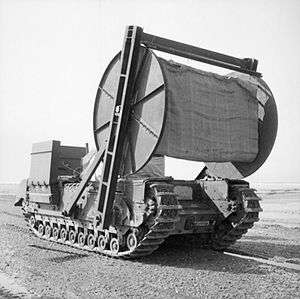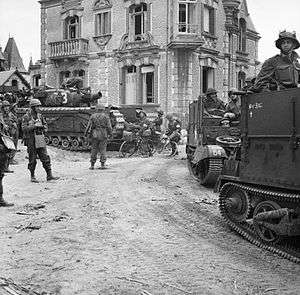1st Assault Brigade Royal Engineers
| 1st Assault Brigade Royal Engineers | |
|---|---|
| Active | 1943–1945 |
| Country | Great Britain |
| Branch | British Army |
| Type | Engineers |
| Role | Armoured Engineers |
| Size | Brigade |
| Part of | 79th Armoured Division |
| Engagements |
D DAY Operation Infatuate Operation Blackcock Operation Plunder |
The 1st Assault Brigade Royal Engineers was a specialisied armoured formation of the British Army active in World War II. It was formed in mid-1943 and its structure was three Assault Regiments of the Royal Engineers. It was assigned to the 79th Armoured Division in preparation for the Normandy invasion of 6 June 1944. The unit comprised armoured vehicles modified for specialist roles (also known as Hobart's Funnies), intended to assist with the landing phase of the operation.
History


By the end of October 1943, various engineer units had been renamed and transferred into the Brigade. This brigade comprised 3 Assault Regiments, each with 4 Assault Squadrons, plus an Assault Park Squadron. This structure remained unchanged up to the Normandy landings in June 1944.
The basic vehicle of the assault unit was the Armoured Vehicle Royal Engineers (AVREs). This was a Churchill tank with its turret modified or removed and to which were attached certain special equipments.
The Brigade was employed during the assault landings in Normandy, Operation Overlord and further used during the battle for the Roer Triangle (Operation Blackcock), the Rhine crossings (Operation Plunder) and the Elbe crossing.
Brigade Units
- 5th Assault Regiment, R.E.
- 6th Assault Regiment, R.E.
- 42nd Assault Regiment, R.E.
Equipment
- AVRE - Armoured Vehicle, Royal Engineers was a Churchill tank adapted to attack German defensive fortifications. The crew included two Royal Engineers who could easily enter the tank through its side hatches. The AVRE had the main gun replaced by a Petard Spigot Mortar. This fired a forty-pound (18 kg) HE-filled projectile (nicknamed the Flying Dustbin) 150 yards (137 metres). The "Dustbin" could destroy concrete obstacles such as roadblocks and bunkers. This weapon was unusual in that it had to be reloaded externally - by opening a hatch and sliding a round into the mortar tube from the hull. AVREs were also used to carry and operate equipment such as:
- Bobbin - A reel of 10-foot-wide (3.0 m) canvas cloth reinforced with steel poles carried in front of the tank and unrolled onto the ground to form a "path", so that following vehicles (and itself) would not sink into the soft ground of the beaches during the amphibious landing.
- Fascine - A bundle of wooden poles or rough brushwood lashed together with wires carried in front of the tank that could be released to fill a ditch or form a step. Metal pipes in the center of the fascine allowed water to flow through.
- Small Box Girder was an assault bridge that was carried in front of the tank and could be dropped to span a 30-foot (9.1 m) gap in 30 seconds.
- Skid Bailey was a larger assault bridge made of normal Bailey Bridge on skids. This was towed and then pushed by an AVRE over gaps up-to 80-foot (24 m).
- Bullshorn Plough. A mine plough intended to excavate the ground in front of the tank, to expose and make harmless any land mines.
- Double Onion two large demolition charges on a metal frame that could be placed against a concrete wall and then detonated from a safe distance. It was the successor to the single charge device Carrot.
- Snake was a pipe based mine clearance device carried on the trackguards. The pipes were filled with explosive, propelled across the field, and then detonated
- ARK Armoured Ramp Carrier was a Churchill tank modified with turret removed and pivoting ramps fitted fore and aft. The vehicle was driven into gaps and ditches where the ramps deployed. The vehicle itself then formed a bridge over which other vehicles could pass.
- D7 (Armd) Dozer was a normal bulldozer fitted with light armour to protect crew members during beach operations.
- Centaur Dozer was a larger fully armoured bulldozer built on the hull of the Centaur (Cromwell) tank.
- Conger was a hose based mine clearance device built in the hull of a Universal Carrier. This had no engine, and was towed by another vehicle. The hose was propelled across the field by rocket, and then liquid high explosive pumped through and detonated.
- Buffalo was an amphibious LVT4 tracked vehicle used by 5 Regiment for inland water crossings.
- Terrapin was a wheeled amphibious vehicle used with Buffalo.
D Day , Operation Overlord
Each of the three Infantry Divisions involved in the first assault on the British and Canadian front - Gold Beach, Juno Beach and Sword Beach - included two Assault Squadrons from 5 Assault Regiment and 6 Assault Regiment, Royal Engineers.
The objective of each pair of Assault Squadrons was to clear lanes across the beaches and to establish up to eight exits from the beaches onto the first inland road, suitable for tracked vehicles. Which involved removing beach obstacles which were exposed at low tide so that they were not a hazard as the tide rose. Disarming and removing mines and other explosive charges from these obstacles. Breaching the sea wall, where one existed, and creating and maintaining ramps and firm access routes through the soft sand above the high water line. Removing knocked-out vehicles which were obstructing these exits.
All this had to be done under fire from buildings on the seafront, and under mortar and artillery fire from further inland.
Each Assault Squadron was equipped with a number of Armoured Vehicles Royal Engineers (AVREs) - which were Churchill tanks, modified in various ways to suit the needs of Assault Engineers. In addition, the assault teams included a number of Sherman 'Crabs' from 30th Armoured Brigade, these were Sherman tanks, with a full-width, heavy duty, rotary chain flail mounted in front which destroyed any mines in its path, thus clearing the lanes up the beach.


The AVREs then turned their attention to the first line of land defences, using their spigot mortars, and with self-propelled guns providing artillery support. More Sappers landed to continue the clearance of the beaches. All the time, infantry were moving through into the growing bridgehead.
Several exits were open within an hour of first landings, allowing the Armoured Brigades to start moving inland.
The Assault Regiments suffered their share of casualties. In some sectors, up to 50% of the flail tanks, AVREs and armoured bulldozers had been knocked out, with high casualties among the crews. But many of the objectives for D-Day had been achieved which may not have been the case without 1st Assault Brigade R.E..
After Normandy the Brigade was used in Operation Blackcock, Operation Infatuate and Operation Plunder.
Assault Engineers after the War
After the end of the Second World War, 79th Armoured Division was disbanded in August 1945. The remaining Assault Engineer Regiment was disbanded in July 1957 and briefly reformed as 32nd Armoured Engineer Regiment, in 1964 before a further reorganisation in 1969 reduced the Armoured Engineers to one squadron.
In 1980, 32 Armoured Engineer Regiment was again reformed and was the largest tank regiment in the British Army. The Regiment was the only unit equipped with specialist Sapper tanks and heir to the traditions of past assault and armoured engineers. The regimental crest includeded the bull's head device of 79th Armoured Division.
32 Armoured Engineer Regiment had three squadrons each of 4 troops, a total of 72 tanks. Each troop had 3 AVREs and 3 AVLBs (bridge layers). The AVRE has a wide range of capabilities including launching fascines (large pipe bundles) into anti tank ditches, laying trackway, clearing mines, dozing and destroying enemy strong points. The bridge layer can lay a scissor bridge over a gap up to 23m wide or a fixed bridge over smaller gaps up to 12m. The complete launching sequence takes less than five minutes. Larger gaps can be crossed using bridges in combination.
As of 2008 Engineer Regiments attached to Armoured or Mechanised Brigades in the British Army, have Armoured Engineer Squadrons included within their organisation.
See also
References
Further reading
- A.R.E. The story of the 1st Assault Brigade Royal Engineers 1943-1945 (1st Assault Brigade, 1945) 78p. Printed for members of the Brigade.
- The story of 79th Armoured Division, October 1942-June 1945 (Germany : 79th Armoured Division, 1945) 314 p.
- N.W. Duncan. 79th Armoured Division (Hobo's Funnies) (Windsor : Profile Publications, 1972) 70 p. (Profile book ; 3)
- Geoffrey W. Futter. The Funnies : the 79th Armoured Division and its specialised equipment (Hemel Hempstead : Model and Allied Publications, 1974) x, 131 p. (A Bellona book)
- David Fletcher. Vanguard of victory : the 79th Armoured Division (London : Her Majesty's Stationery Office, 1984) 86 p.
- Patrick Delaforce. Churchill's secret weapons : the story of Hobart's Funnies (London : Robert Hale, 1998) 256 p.
External links
- http://www.remuseum.org.uk/biography/rem_bio_hobart.htm
- http://www.unithistories.com/units_british/79ArmdDiv.htm